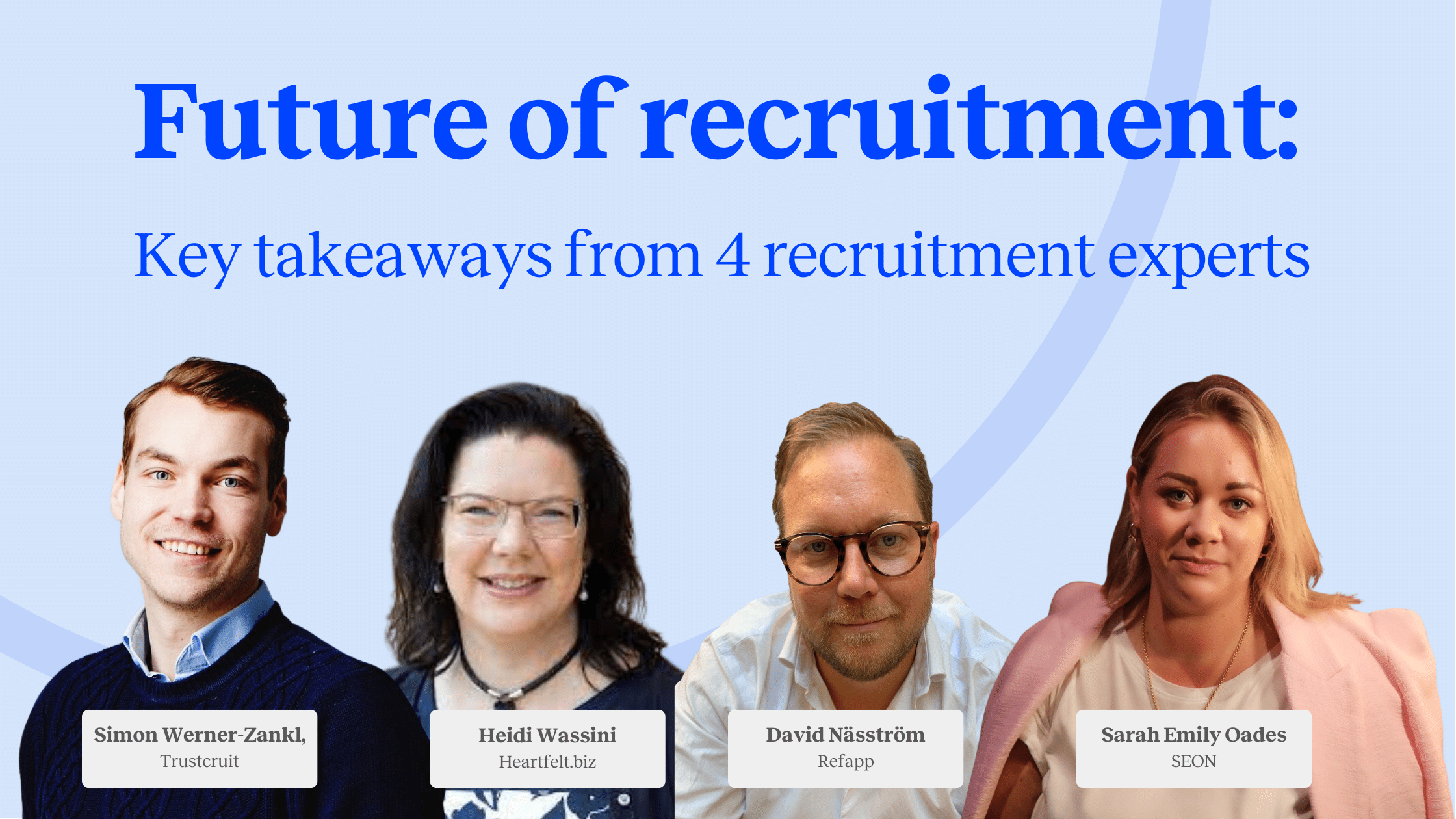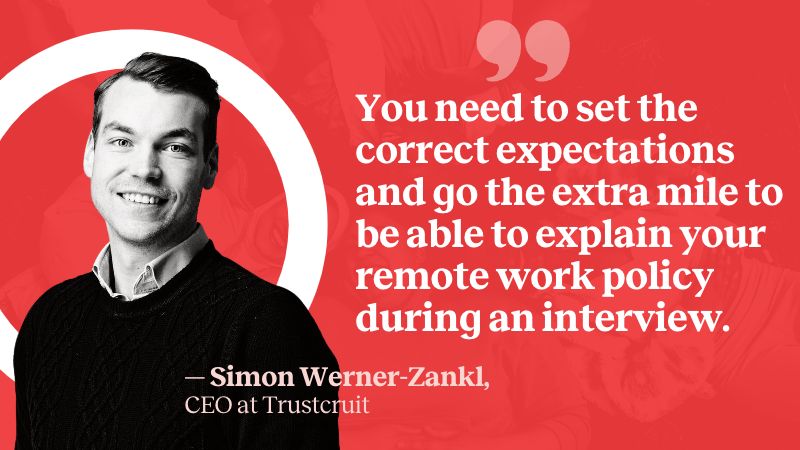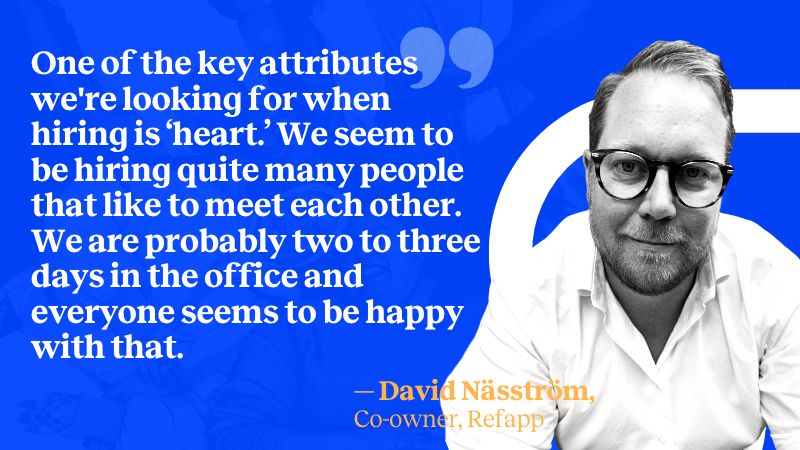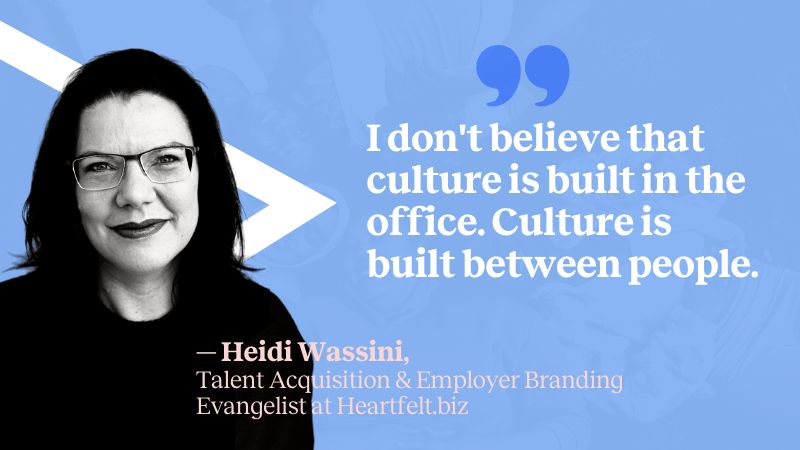
Jan Söderström

2022 has no doubt been a tough year for HR and recruitment. Economic uncertainty, the cost of living crisis, and remote work dilemmas will continue to bring challenges to recruitment this year.
What can you do as an HR or talent acquisition specialist to stay ahead of the curve this year?
We spoke with four recruitment experts from Sweden, Denmark, and the UK in a webinar to hear their thoughts and advice on everything from strict return-to-office policies to navigating hiring with the rising cost of living.
In this post, we’ll dive into this year’s top recruiting trends and share insights and key takeaways from these recruitment experts.
Want to watch the 2023 recruiting trends webinar (part 1)? Get your recording here.
Restrictions and lockdowns due to Covid led many organizations to realize that people can, in fact, work well remotely. Several studies have highlighted the many benefits of remote work for both organizations and employees, like increased productivity and improved employee wellbeing.
But recently, big tech companies like Twitter and Tesla have introduced strict return-to-office policies, which led many employees to walk out.
“Strict return-to-office policies have no thought for diversity, priviledge, and the conditions people have,” says Heidi Wassini, Talent Acquisition & Employer Branding Evangelist at Heartfelt.biz.
How should you approach the question of returning to the office within your organization and with candidates?
“It's really important to be clear as a recruiter on the purpose of returning to the office, and to explain that purpose to candidates in the interviews,” says Sarah-Emily Oades, VP of People at SEON.
If you’re in the process of figuring out a hybrid work model, focus on the purpose your office now serves. There is no cookie cutter answer here—each organization must figure out what hybrid work policy works best for them.
After clarifying your remote work policy and ‘why’ for returning to the office, be prepared to communicate it to candidates. For example, you might explain to a candidate that employees go to the office for things that are proven to be best done in-person, but that it varies from team to team.
Simon Werner-Zankl, CEO at Trustcruit, emphasizes the importance of communication: “You need to set the correct expectations and go the extra mile to be able to explain your remote work policy during an interview.”

For example, Sarah-Emily’s talent acquisition team at SEON took a staggered return to the office. During interviews, they explain to candidates why they now meet at the office two to three days a week, where lunch is provided by the company.
David Näsström, Co-owner, Refapp, takes a similar approach: “One of the key attributes we're looking for when hiring is ‘heart.’ We seem to be hiring quite many people that like to meet each other. We are probably two to three days in the office and everyone seems to be happy with that.”

Many organizations struggle to get employees at the office without making it a requirement (and risk losing top talent). If this is the case in your organization, focus on why you do want employees at the office—not why you don’t want them working from home.
Heidi explains, “Rather than see the situation as black and white, I would be curious as to why it’s needed to be at the office a certain number of times a month or week, and what is the challenge for candidates?”
While certain activities might make more sense to do in person—like team building and networking—be open-minded to different ways of fostering connections between employees.
While some employees might thrive when socializing with colleagues, others might feel intimidated to come to the office for team building. To create an inclusive environment, consider employees’ different preferences for working and socializing.
“I don't believe that culture is built in the office. Culture is built between people,” says Heidi.

|
Key takeaways:
|
Many recruiters and talent acquisition specialists have been forced to shift their focus due to hiring freezes and mass layoffs.
Despite these layoffs, many companies are still hiring. How can you best approach this topic with candidates?
“As a company, you really need to think about the way you lay people off. If you lay people off with a human connection and you do your utmost to give them the best possibilities to move on, it will be so much easier for recruiters to explain to a new hire how the layoffs make sense from a business perspective,” says Heidi.
On the other hand, if the company isn’t treating people right, recruiters and TA would struggle to explain the layoffs in an authentic way. “No matter the words you say, if you don't believe it inside, it's going to shine through in the interview,” Heidi continues.
At the start of the Covid pandemic, many companies were quick to cut down on talent acquisition managers and specialists. However, these companies lost a lot of time rebuilding their pipelines as they soon had to rehire TA talent.
A lesson learned from how these companies handled layoffs is that it can be short-sighted to immediately offboard your TA team. In every crisis over the previous years, there has always been a need for key talent.
When it comes to hiring, don’t fall into the cycle of constantly hitting the gas and pumping the brakes. Instead, build a long-term talent pool that will make your work easier when you need to hire again.
“If you're working within areas where you have a competency gap, take the chance now to hire people. There’s a big opportunity for companies now to lower the competence gap,” recommends David.
When there’s a lull in active hiring, take the time to assess your recruitment processes and talent operations. Are all your systems talking to each other? How’s your pipelining and candidate pools? How can you work even more efficiently going forward?
“With my TA team, we've been concentrating on ensuring that our process is up to scratch. These layoffs actually create higher expectations from candidates because they're looking for security—especially if you're looking to hire someone who already has security, then you need to show them you're offering even better security,” says Sarah-Emily.
There’s more to TA than just hiring—this function is closely connected to the business. While it can be difficult for TA to focus less on scaling teams and more on getting processes right, it’s worth it in the long run.
Remember that ebbs and flows are a natural part of recruitment. “I always picture recruitment going up and down like a wave. We need to know what we do when we're up, and we need to understand what we do when we're down,” says Heidi.
|
Key takeaways:
|
The rising cost of living also brings higher expectations from candidates. How can you tackle candidates’ concerns in the interview process?
Make sure you’re checking the latest salary benchmarks and that your TA team has all the information they need at hand. TA specialists need to be plugged into both the market and your internal team to effectively communicate with candidates.
“It’s about how you connect your talent team to your business team. You need internal mechanisms in place that allow you to adjust whenever the requirement is there,” says Sarah-Emily.
It’s crucial to make the adjustments necessary to secure the talent you need in order to grow as a business. For example, if there’s a half yearly increase in the cost of living, then do a compensation review every six months. Some companies are also offering one-off bonuses to help employees cope with rising costs.
No matter how you support employees, your company needs to have a response to the rising cost of living. Without one, TA will be left in an uncomfortable position and candidates will be left unengaged.
“As a business, if you're not giving your talent team the tools they need, then you will lose candidates. If people think that you don't care that their electricity bill has gone from 40 to 400 pounds a month, then they're not going to come and work for you,” says Sarah-Emily.

|
Key takeaways:
|
Essential talent acquisition skills include social skills, listening skills, communication skills, and interviewing skills. But TA is about more than just interviewing.
“For the future of TA, I’m sure we will use more data to make our decisions. The ones running the process should be more into analyzing the data points. It’s also about being more unbiased,” says David.
One TA specialist shouldn’t have to wear all the hats. Skills like sourcing, researching, recruiting, operations, and being a business partner should be covered by different members of your team. Things like email templates and systems integrations should be taken care of by someone else so that the TA team can focus on their core work.
“Sometimes you can combine some skills, but I don’t believe that one person should do all of these things. We need to see more specializing in these areas,” says Heidi.
Being a talent acquisition business partner involves understanding the engagement surveys, exit surveys, and all HR numbers like employee attrition, employer brand feedback, and brand recognition.
“I think we need to interest ourselves not just with filling jobs, but to understand how things work in the business and the market because it’s so much more agile and volatile,” says Heidi.
If you’re a small company, it can be difficult to expand your talent acquisition team to cover all these skills sets. In this case, think about what skills you need the most right now—maybe it’s a researcher, sourcer, and recruiter. Keep in mind you can also have four skill sets among two people, for example.
“As the business grows—maybe to around 150-200 people—then you need to start adding that business partnering aspect if you really want to understand how to best grow your talent in the company,” says Heidi.
Sarah-Emily shares that advocacy skills—being able to stand up to and challenge stakeholders—is the single biggest skill gap she’s seen in her TA teams. This comes back to being a business partner: senior TA specialists should understand the business well enough to be able to push back when needed. For example, they can ask “Why are you hiring for these skills when the company is going in this direction?”or “Talk to me about this interview feedback—what do you mean when you say they’re not a cultural fit?”
“It's a very difficult skill to teach, and the comfort that you need to feel in your environment in order to develop that skill is pretty extreme. But it is the most valuable skill you can hire for,” says Sarah-Emily.
|
Key takeaways:
|
Navigating the current recruiting landscape is no easy feat—there is no one-size-fits-all solution to the challenges facing recruiters and TA teams today. To prepare for the year ahead and meet candidates’ expectations, communicate openly about these topics with your team, organization, and candidates.
To dive deeper into the 2023 recruiting trends, check out our on-demand webinar 2023 is here, but are you ready for it?Learn from these four recruitment experts about the right tool stack, top employer branding strategies, and ways to minimize gender and other biases in your hiring process.
Get recruitment insights, tips, and best practices delivered to your inbox monthly!